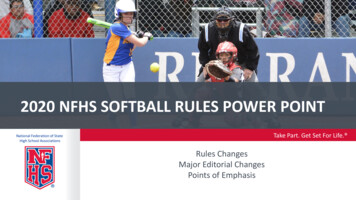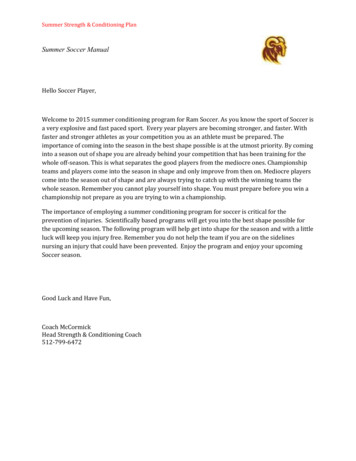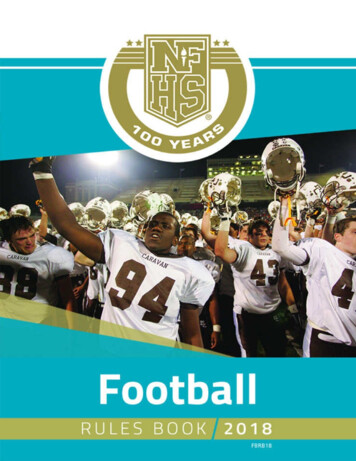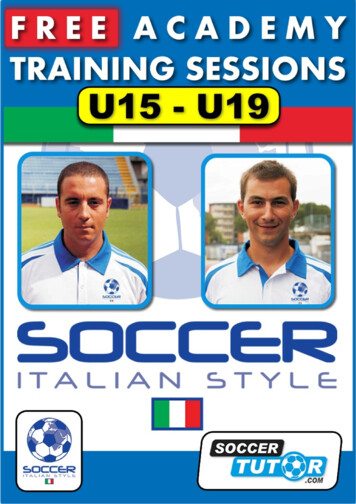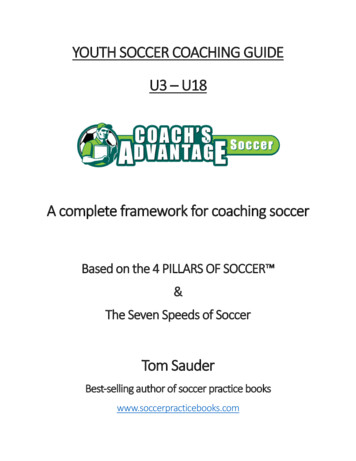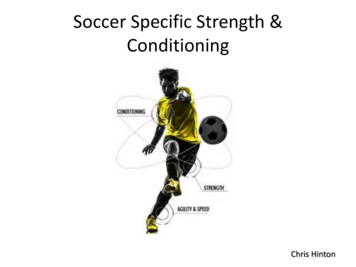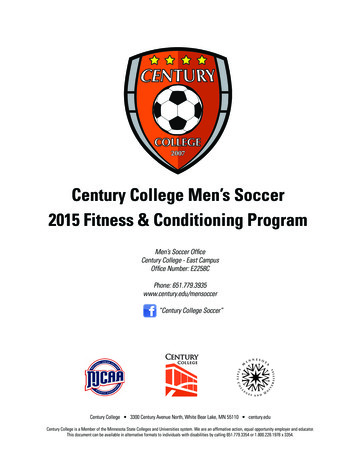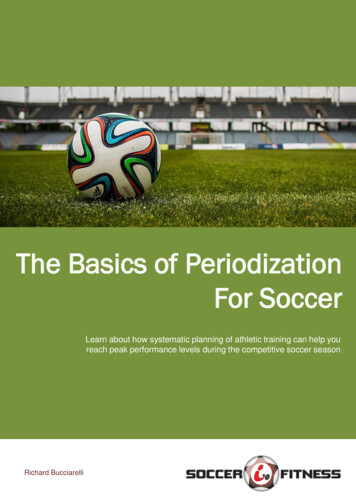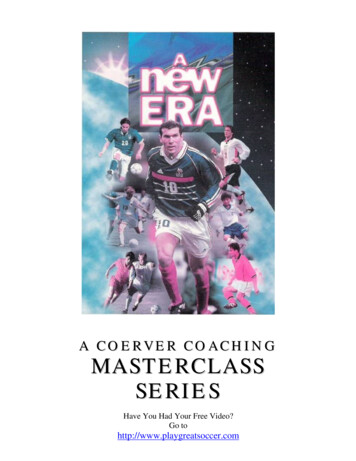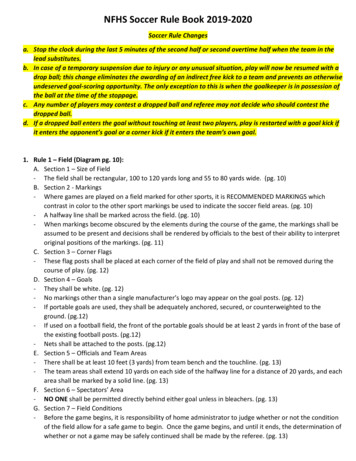
Transcription
NFHS Soccer Rule Book 2019-2020Soccer Rule Changesa. Stop the clock during the last 5 minutes of the second half or second overtime half when the team in thelead substitutes.b. In case of a temporary suspension due to injury or any unusual situation, play will now be resumed with adrop ball; this change eliminates the awarding of an indirect free kick to a team and prevents an otherwiseundeserved goal-scoring opportunity. The only exception to this is when the goalkeeper is in possession ofthe ball at the time of the stoppage.c. Any number of players may contest a dropped ball and referee may not decide who should contest thedropped ball.d. If a dropped ball enters the goal without touching at least two players, play is restarted with a goal kick ifit enters the opponent’s goal or a corner kick if it enters the team’s own goal.1. Rule 1 – Field (Diagram pg. 10):A. Section 1 – Size of Field- The field shall be rectangular, 100 to 120 yards long and 55 to 80 yards wide. (pg. 10)B. Section 2 - Markings- Where games are played on a field marked for other sports, it is RECOMMENDED MARKINGS whichcontrast in color to the other sport markings be used to indicate the soccer field areas. (pg. 10)- A halfway line shall be marked across the field. (pg. 10)- When markings become obscured by the elements during the course of the game, the markings shall beassumed to be present and decisions shall be rendered by officials to the best of their ability to interpretoriginal positions of the markings. (pg. 11)C. Section 3 – Corner Flags- These flag posts shall be placed at each corner of the field of play and shall not be removed during thecourse of play. (pg. 12)D. Section 4 – Goals- They shall be white. (pg. 12)- No markings other than a single manufacturer’s logo may appear on the goal posts. (pg. 12)- If portable goals are used, they shall be adequately anchored, secured, or counterweighted to theground. (pg.12)- If used on a football field, the front of the portable goals should be at least 2 yards in front of the base ofthe existing football posts. (pg.12)- Nets shall be attached to the posts. (pg.12)E. Section 5 – Officials and Team Areas- There shall be at least 10 feet (3 yards) from team bench and the touchline. (pg. 13)- The team areas shall extend 10 yards on each side of the halfway line for a distance of 20 yards, and eacharea shall be marked by a solid line. (pg. 13)F. Section 6 – Spectators’ Area- NO ONE shall be permitted directly behind either goal unless in bleachers. (pg. 13)G. Section 7 – Field Conditions- Before the game begins, it is responsibility of home administrator to judge whether or not the conditionof the field allow for a safe game to begin. Once the game begins, and until it ends, the determination ofwhether or not a game may be safely continued shall be made by the referee. (pg. 13)
2. Rule 2 – Ball:A. Section 1 - Supply- Responsibility of HOME team to provide three or more official game balls of similar quality. If the hometeam cannot provide three balls, the referee shall choose game balls from those offered by both teams.(pg. 14)B. Section 2 - Specifications- The weight of the balls at the start of the game shall be at least 14 ounces, but no more than 16 ounces.(pg. 14)- The ball shall include the NFHS Authenticating Mark. (pg. 14)3. Rule 3 – The Players and Substitutions:A. Section 1 – Numbers of Players- Game shall be played by two teams, each consisting of not more than 11 players, one of whom shall bethe goalkeeper. (pg. 15)- Each team shall designate a team captain on the field who is the team s representative, may address anofficial on matters of interpretation, and may address an official to obtain essential information. (pg. 15)- A game shall not be started with fewer than seven properly uniformed players on each team. After thegame has started, it may not be continued with fewer than seven players on either team; failure to do so,game shall be terminated and a forfeit shall be declared.EXCEPTION: if team drop below 7 players due to a player having to leave field for temporary equipmentrepair, minor injury, blood-rule situation, the official may stop the game momentary until the problem iscorrected and then continue the game. (pg. 15)- Each team must submit a team roster of all players, substitutes, bench personnel, and all coaches, to theofficials at least 5 minutes prior to the start of the contest. The game shall not begin until this iscomplete. Players, substitutes, bench personnel, and coaches may be added to the roster after the startof play. Goalkeepers may have two numbers listed on the roster a goalkeeper’s number and a fieldplayer’s number. (pg. 15)B. Section 2 – Position of Players- The team winning the coin toss shall have the option of choosing which end of the field to defend or totake the kickoff. (pg. 16)C. Section 3 – Substitutions- Either team may substitute and unlimited numbers of players from the bench between periods. (pg. 16)- Either team may substitute and unlimited numbers of players from the bench, provided they report tothe nearest official and are beckoned in: a goal is scored, when a player is injured (coach or appropriatehealth-care professional may not enter the field without approval from a referee), if the referee stops theclock for an apparent injury to a field player or goalkeeper, the field player or goalkeeper will have toleave the field; the field player may be replaced, and the goalkeeper shall be replaced by either asubstitute or a field player. (pg. 16)- Any player who exhibits signs, symptoms of concussion (headache, dizziness, confusion, or balanceproblems) shall be immediately removed from the contest and shall not return to play until cleared by anappropriate health-care professional. (pg. 16)- If the injured player is being replaced during a penalty kick situation, substitutes may not take the penaltykick. (pg. 16)- Either team may substitute and unlimited numbers of players, provided they report to the nearest officialand are beckoned in: a goal kick, when a player from either team is cautioned (yellow card), a player is
disqualified (red card), communicable disease concerns (athlete who is bleeding), when bench personnelis cautioned or disqualified. (pgs. 16-17)- The team in possession of the ball may substitute an unlimited number of players: on a throw-in and on acorner kick. (pg. 17)- The team NOT in possession of the ball may substitute an unlimited number of players at a throw-in orcorner kick if the team in possession of the ball is also substituting. (pg. 17)- A substitute becomes a player when he/she is beckoned onto the field of play, at which the replacedindividual is no longer a player. (pg. 17)- BECKONED IN SCENARIO 3.3.3 SITUATION F. (pg. 19)D. Section 4 – Procedure for Substitution- A substitute may enter the field of play at the beginning of a period without being beckoned by thereferee. After a score and when a player is injured and removed from the field, substitutes MUST bebeckoned. (pg. 20)- The clock shall be stopped when a substitute by the team in the lead is beckoned onto the field in thefinal five minutes of the second period only (this included second overtime period). (pg. 20)E. Section 5 – Goalkeeper Change- The goalkeeper may change places with a player on the field whenever the clock is stopped or asubstitution takes place, provided the uniforms are legal. Any time the goalkeeper is changed, a refereeshall be notified. PENALTY: Both players (goalkeepers) shall receive a warning at the next stoppage ofplay. (pg. 21)F. Section 6 – Excessive Player Substitutions- When a team repeatedly substitutes to consume time, a referee shall order the timer to stop the timeclock during such substitutes and shall notify the coach of the offending team. The repetition may beconsumed as unsporting conduct. (pg. 21)4. Rule 4 – Player Equipment:A. Section 1 – Required Equipment- The required player equipment includes a jersey, shorts, socks, suitable shoes and shinguards. TheNOCSEA seal and height range shall be permanently marked on the front of the shinguards. (pg. 22)- Requirement for uniforms: home team shall wear solid white jerseys and solid white socks; the visitingteams shall wear dark jerseys and socks (dark is defined as any color which contrasts with white). (pg. 22)- Prior to and during the game, jerseys shall be tucked into the shorts, unless manufactured to be wornoutside. (pg. 22)- Both socks shall be the same color, with the home team wearing a solid white socks and the visiting teamwearing socks of a single dominant color, but not necessarily the color of the jersey. If tape or a similarmaterial (stays/straps) is applied externally to the socks, it must be of similar color as that part of thesock to which it applied. (pg. 22)- If visible apparel is worn under the jersey and or shorts, it shall be of a similar length and a solid-like colorfor the team. (pg. 23)- All jerseys, including the goalkeeper’s jersey, shall be numbered on the back and on the front (jersey orshorts) with the same number. Numbers shall be of a solid contrasting color to the jersey (or shorts) andclearly visible. (pg. 23)- Only those names, patches emblems, logos or insignias referencing the school are permitted on the teamjersey and/or shorts; the player’s name may also appear in uniform. (pg. 23)- The jersey of the goalkeeper shall distinctly differ in color from that of any teammate or opposing fieldplayer. The socks of the goalkeeper are not required to be the same color as his/her teammates, butshall differ in color from the opposing field players. (pg. 23)
-Shoes with soles containing metal (aluminum, magnesium, titanium, etc ), leather, rubber, nylon, orplastic cleats , studs, or bars, whether molded as part of the sole or detachable, are allowed as long asthe referee does not consider them dangerous. (pg. 23)- It is recommended that team captains wear an upper arm band of a contrasting color; the captain’s band,if worn, shall be worn on the upper arm. (pg. 23)B. Section 2 – Other Equipment- Illegal equipment shall not we worn by any player. This applies to any equipment which, in the opinionof the referee, is dangerous or confusing. (pg. 26)- Hard and unyielding items (guards, casts, braces, etc ) on the hand, wrist, forearm, elbow, upper arm orshoulder, unless covered, and must be padded with a closed-cell, slow recovery foam padding no lessthan 1/2-inch thick. (pg. 26)- Knee braces which are altered from the manufacturer’s original design/production are illegal. Kneebraces that are unaltered are legal and do not require any additional padding. (pg. 26)- Non-metal ankle braces that are unaltered are legal and may be worn outside a sock. Ankle braces ofmetal or unyielding material that are unaltered are legal if covered by a sock.- Hats, caps, or visors are illegal; goalkeeper may wear a soft-billed baseball type hat or soft-billed visor.(pg. 26)- Players may wear soft and yielding caps during inclement weather. Caps must be alike in color. NOTE:The wearing of illegal uniforms or equipment is prohibited even though the coaches of both teamsapprove it. (pg. 26)- Hair control devices may be worn if made of soft material and not for adornment (pg. 26)- Sweatbands may be worn on the head or wrist if made of soft material. (pg. 26)- Jewelry shall not be worn except for religious or medical medals (a religious medal must be taped andworn under uniform; a medical alert must be taped and may be visible). (pg. 26)- Hearing aids worn in or behind the ears, including cochlear implants, are legal provided that the devicedoes not create the threat of injury. (pg. 27)- A tooth or mouth protector, if worn shall be made of any readily visible color, not be completely white orclear. (pg. 27)- A protective face mask may be worn by a player with a facial injury. The mask may be made of hardmaterial, but must be worn molded to the face. A medical release for the injured player signed byappropriate health-care professional shall be available at the game site. (pg. 27)- Soft-padded headgear is permitted. (pg. 27)C. Section 3 – Coaches’ Responsibilities- Each head coach shall be responsible for ensuring that each of his/her players is properly and legallyequipped. (pg. 29)- PENALTY ILLEGALLY EQUIPPED PLAYER: The head coach shall receive the first caution issued (yellowcard) for an illegally equipped player. All subsequent cautions (yellow cards) for illegally equippedplayer(s) shall be issued directly to the player(s) and not to the head coach. The player must beremoved and may be replaced at the time of the caution to the coach or player. (pgs. 29-30)- An illegally equipped player shall be instructed to leave the field of play when the ball next ceases to bein play. Play shall not be stopped for an infringement of this rule except where the referee may stop playimmediately where there is a dangerous situation. (pgs. 29-30)- Cautions will not be issued for improperly equipped player(s). They shall be instructed to leave the fieldof play when the ball next ceases to be in play. (pg. 30)5. Rule 5 – The Officials:A. Section 1 – General
-The officials shall be a head referee and a referee (2 men system) or a head referee and two assistantreferees assisted by a timer, scorers and at least 2 ball holders. (pg. 31)- The jurisdiction of the officials shall begin on their arrival at the field of play and its immediatesurroundings (to begin their official responsibilities), which shall be no later than 15 minutes prior to thestart of the game and end with their leaving the field of play and its immediate surroundings. (pg.31)- The officials can only correct a decision so long as the game has not been restarted. (pg. 31)- State associations may intercede in the event of unusual incidents that occur before, during or after theofficials’ jurisdiction has ended or in the event that a contest is terminated prior to the conclusion ofregulation play. (pg.31)- The officials shall not use any tobacco products during this time. (pg. 31)- The officials shall be dressed alike in the uniforms primary consisting of: shirt approved by stateassociation, black shorts or long trousers, predominately black shoes and black knee socks with whitehorizontal stripes, a solid black cap. (pg. 31)- Unless prohibited by the state association, electronic communication devices may be used by officials tocommunicate. (pg. 31)B. Section 2 – Pregame Responsibilities- Officials shall be in uniform at the site of the game no less than 15 minutes before the scheduledstarting time. The head referee shall conduct a pregame conference briefly reviewing the duties of allofficials. (pg. 32)- Conduct a pregame conference with the head coach and team captains to: review rules, address goodsportsmanship, conduct coin toss, and inquire of each head coach whether each of his/her players will beproperly and legally equipped at the kickoff. (pg. 32)- Assistant referees must assist the center referee in inspecting game balls and field of play. (pg.32)C. Section 3 – During the Game- If the referee applies the advantage, which was anticipated but does not develop at that time, thereferee shall penalized the original offense. (pg. 33)- Hold a yellow card or red card with arm fully extended above a referee’s head and indicate the player orcoach being carded. (pg. 33)- If a player, coach, or bench personnel is being disqualified for a second yellow card, the referee will showa yellow card indicating the subsequent caution followed immediately by showing a red card. (pg.33)- Have the authority to terminate a game when stated rule and conditions warrant. (pg.33)- Have the authority to suspend play or terminate the game whenever the elements, spectators, or othercauses require. (pg. 33)- Have the power to make decisions on any point not specifically covered in the rules. (pg. 33)- Confirm or overrules the assistant referees’ signals. (pg. 33)- Instruct the timer to correct the clock, when necessary. (pg. 33)- Deflecting the ball with hands inside penalty area SCENARIO: if ball goes in, give yellow card and goalcounts; if ball doesn't go in, award a penalty kick and red card player for serious foul play. (pg. 34)- Ejecting Soccer Coach: Coach must be removed from the vicinity of the playing area. The coach shall beprohibited from further contact, direct or indirect, with the team members during the remainder of thegame. Failure to comply shall result in termination of the game. (pg. 34)- Officials may temporarily suspend play due to the elements or emergencies (extremely humid conditions,thunderstorms, power failure). (pg. 34)- If a game is terminated due to a fight among players of both teams, no winner is declared by the officialand all conditions regarding the incident shall be reported to the proper authorities in writing. (pg. 34)D. Section 4 – After the Game
-The head referee shall report in writing any disqualifications and unusual incidents to the properauthorities. (pg. 35)6. Rule 6 – Ball Holders, Timer, and Scorer:A. Section 1 – Ball Holders- At least 2 ball holders shall be provided by the home team. If the home team cannot provide ballholders, the visiting team may; they are under direct supervision of officials. (pg. 35)B. Section 2 – Timer- The official timer shall start the timing device when the ball is put into play and stop the timing devicewhen signaled to do so by a referee: for an injury, for a penalty kick, for a caution, for a disqualification,following the scoring of a goal, and when an official orders the clock to be stopped. (pg. 35)7. Rule 7 – Duration of the Game and Length of Periods:A. Section 1 – Lengths of Periods- Two equal halves of 40 minutes shall be played. It is recommended junior high school play 30-minutehalves. (pg. 36)- In the event a games must be suspended because of conditions which make it impossible to continueplay, the head referee shall declare it an official game if one complete half or more of the game has beenplayed. If less than one-half of the game has been played, the game may be re-scheduled from the start,or restarted from the suspension of play according to state association adoption. (pg. 37)- Play shall be extended beyond the expiration of a period, in regulation time and overtime, to permit apenalty kick to be completed. (pg. 37)- Penalty Kick Scenario: when time expires and with two seconds remaining in the game (ball is deflectedby goalkeeper and is shot back into the goal by a teammate of the kicker); GOAL if the ball enters thegoal prior to the expiration of time, but NO GOAL if time expired. (pg. 37)B. Section 2 – Intervals between Periods- The halftime shall be 10 minutes unless opposing coaches mutually agree to a different length. (pg. 37)C. Section 3 – Tie Games- Regular-season games which are tied at the end of 80 minutes of play may be resolved by proceduresadopted by state high school associations. NOTE: No overtime procedures shall exceed 20 minutes ofplay during the regular season. (pg. 37)- The interval between the second half and the first overtime shall be five minutes. (pg. 38)- The interval between first overtime period and second overtime period shall be two minutes. (pg. 38)D. Section 4 – Time-Out and In- The clock shall be stopped for an injury, for a penalty kick, for a cautioning (yellow card), fordisqualifications (red card), following the scoring of a goal and when a referee orders the clock to bestopped. (pg. 38)- The clock is restarted when the ball is properly put into play, NOT when the whistle blows. (pg. 37)E. Section 5 – Play- If a team refuses to play after being instructed to do so, the game is terminated. (pg. 38)8. Rule 8 – The Start of Play:A. Section 1 – Kickoff- When the referee signals with a whistle, a kickoff shall initiate play at the start of each period. (pg.38)- At the moment of kickoff, all players, except the player taking the kickoff, shall be in their team’s half ofthe field. Players opposing the kicker shall be at least 10 yards from the ball until it is kicked. (pg. 38)- The ball is kicked and clearly moves in any direction. (pg. 38)
--After the kickoff, the ball may be played by any player except the one who kicked off. The kicker may notplay the ball until it has been played or touched by another player on either team. PENALTY: Indirect freekick awarded to the opponent at the spot of the foul. (pg. 38)Kickoff can be done by kicking ball backward. (pg. 39)9. Rule 9 – Ball In and Out of Play:A. Section 1 – Ball In and Out of Play- The ball is out of play when it has completely crossed a goal line or touchline, whether on the ground orin the air. (pg. 39)- The ball is in play at all other times including: when it rebounds a goal post, crossbar, or corner flag posts,when it touches an official on the field of play, or when a drop ball touches the ground. (pg. 39)- A second whistle is required to restart play for the taking of a penalty kick, after a substitution is made,after a caution, red card, injury and AFTER setting a wall prior to a free kick. (pg. 39)- Offense team is the only one that can request a wall (10 yards); play shall be restarted by a secondwhistle. (pg. 40)B. Section 2 – Drop Ball- The game is restarted with a drop ball: when the ball is caused to go out-of-bounds by two opponentssimultaneously, when the ball becomes deflated, following a temporary suspension of play for an injuryor unusual situation and a goalkeeper is not in possession of the ball, when simultaneously fouls of thesame degree occur by opponents. (pg. 40)- The ball is dropped by an official from waist level to the ground. Any number of players may contest adropped ball (including the goalkeeper); a referee cannot decide who may contest a dropped ball or itsoutcome. (pg. 40)- The ball shall touch the ground before it is played. PENALTY: if the ball is played before it touches theground, an official shall drop the ball again. (pg. 40)- If a dropped ball enters the goal without touching at least two players, play is restarted with a goal kickif it enters the opponent’s goal or a corner kick if it enters the team’s own goal. (pg. 40)C. Section 3 – Temporary Suspension- In case of temporary suspension due to an injury or any unusual situation, the game shall be restarted bya dropped ball provided the ball was not in the goal area and not in possession of the goalkeeper. (pg. 41)- Should there not be clear possession at the time play is suspended due to an injury or any unusualsituation, there will be a drop ball at the spot where the ball was declared dead. (pg. 41)10. Rule 10 – Scoring:A. Section 1 – Goals- A goal is cored when the entire ball passes beyond the goal line, between the goal posts and under thecrossbar provided it has not been deliberately thrown, carried, or propelled by the hand or arm of aplayer of the attacking team. (pg. 41)- A goal MAY be scored directly from a: kickoff, direct free kick, goal kick, penalty kick, corner kick, dropball, goalkeeper’s throw, punt or drop-kick. (pgs. 41-42)- A goal MAY NOT be scored directly from a/an: indirect free kick, throw in, direct free kick into a team’sown goal, goal kick into a team’s own goal, corner kick into a team’s own goal or a dropped ball. (pg. 42)B. Section 2 – Forfeits- The score of a forfeited game shall be 1-0 if the game is not started, the score is tied or the offendedteam is ahead at that time. If the offending team is behind at the time of forfeit, the core at that time isthe final score. (pg. 42)C. Section 3 – Winner
-The winning team is the team scoring the greater number of goals during the game. (pg. 42)11. Rule 11 – Offside:A. Section 1 – Offside- A player is in offside position when nearer to his/her opponents’ goal line than the ball, unless: the playeris in his/her own half of the field of play or the player is not nearer to the opponent’s goal line than atleast two opponents. NOTE: The position of any part of the player’s head, body or feet will be thedeciding factor, not the player’s arms. (pg. 42)- A player shall not be penalized for being in an offside position if the ball is received directly from a goalkick, a corner kick, or a throw-in. (pg. 42)- It is not an offense in itself to be in an offside position. (pg. 42)- Player is offside and penalized if, at the time the ball touches or is played by a teammate, the player in anoffside position becomes involved in active play by: interfering with play or with an opponent or seekingto gain an advantage by being in that position.- A player in an offside position receiving the ball from an opponent, who deliberately plays the ball(except from a deliberate save), is not considered to have gained advantage. (pg. 42)- PENALTY FOR OFFSIDES: indirect free kick at the spot of infraction. (pg. 43)12. Rule 12 – Fouls and Misconduct:A. Section 1 – Spitting, Kicking, Striking, Tripping, and Jumping- A player shall not kick, attempt to kick, strike, attempt to strike, spit at, or jump at an opponent. (pg. 56)- A player shall not trip, or attempt to trip an opponent. (pg. 56)- A goalkeeper shall not strike or attempt to strike an opponent by throwing or kicking the ball at anopponent or by pushing an opponent with the ball while holding it. (pg. 56)- PENALTY: Direct free kick. (pg. 56)B. Section 2 – Handling- A player shall be penalized for deliberately handling, carrying, striking or propelling the ball with hand/arm. Exception: GK when ball is within his/her own penalty area. PENALTY: Direct free kick. (pg. 56)- Protecting the head, face, groin or chest from a hard shot or pass using the hands or arms as a reflex isnot considered deliberate and therefore not handling. (pg.57)C. Section 3 – Holding, Pushing- A player shall not hold or push an opponent with the hand(s) or arm(s) extended from body. PENALTY:Direct free kick. (pg. 57)D. Section 4 – Charging- A player shall be penalized for charging an opponent in a dangerous or reckless manner, or usingexcessive force. An allowable fair charge is where players make shoulder-to-shoulder contact in anupright position, within playing distance of the ball, have at least one foot on the ground and their armsheld close to their body. (pg. 58)- A player shall not, in any manner, charge the goalkeeper in the penalty area unless the goalkeeper isobstructing the player or dribbling the ball with the feet. (pg.58)- An official shall caution any player who flagrantly fouls the goalkeeper in possession of the ball.Possession or control of the ball includes any time the goalkeeper has the ball trapped by either or bothhands or when bouncing it to the ground or when releasing the ball into play. (pg. 58)- Outside the penalty area, the goalkeeper has no more privileges than any other player. (pg.58)- PENALTY: Direct free kick. (pg. 58)- The goalkeeper in possession of the ball shall not be interfered with or impeded in any manner by anopponent. This includes the act of bouncing the ball or dropping the ball for a kick or attempting to throw
E.-F.-G.--H.-the ball or tossing the ball in the air to re-catch. When goalkeepers put the ball on the ground, theyrelinquish their privileges as goalkeepers. PENALTY: Indirect free kick. (pg. 57)A player shall not charge into an opponent when neither player is within playing distance of the ball.PENALTY: Indirect free kick. (pg. 58)Section 5 – ObstructionObstruction is the deliberate act of a player, not in possession of the ball and/or not attempting to playthe ball, of running between an opponent and the ball or moving the body to become an obstacle to anopponent. PENALTY: Indirect free kick. (pg. 59)Section 6 – Dangerous PlayA player shall not participate in dangerous play, which is an act an official considers likely to cause injuryto any player. This includes playing in such manner which could cause injury to self or another player(opponent or teammate.) PENALTY: Indirect free kick. (pg. 59)Section 7 – Restrictions on the GoalkeeperGoalkeeper has six seconds to release the ball into play once he/she takes control of the ball with thehands. Once the ball has been released into play, the goalkeeper may not touch it again with the handsuntil it has been played or touched by another player. (pg. 60)A goalkeeper shall not deliberately parry the ball and then touch it again with his/her hands. (pg.60)On any occasion when a player deliberately kicks the ball to his/her own goalkeeper, the goalkeeper isnot permitted to touch it with his/her hands. (pg. 60).A goalkeeper shall not touch the ball with his/her hands when receiving it directly from a throw-in by ateammate. (pg. 60)NOTE: Players may not use a trickery to circumvent the previous rules. Example: Players may not flick theball with their feet to their own head, chest, or knee and then pass it to their own goalkeeper whotouches it with the hands. (pg.60)PENALTY: Indirect free kick awarded to the opponent at the spot of the violation, unless in the goalarea. (pg. 60)Section 8 – MisconductA player, coach, or bench personnel shall be cautioned (yellow card) for:a. Entering or leaving the field of play (except through the normal course of play) without thepermission of an official. (pg. 61)b. Persistent infringement of any rules of the game. (pg. 61)c. Objecting by word of mouth or action to any decision given by an official (dissent). (pg. 61)d. Any incidental use of vulgar or profane language. Note: this may be a disqualification (red card).(pg.61)e. Any use of electronic communication devices with the on-field players during play. Examples:amplifying devices, wireless communication devices such as cell phones, headphones, personal digitalassistant, etc Note: a coach may engage in verbal communication with his or her own team duringplay. (pg. 61)f. Unsporting conduct, including, but not limited to: coaching outside the team area, unnecessary delay(kicking, throwing the ball away on a free kick, etc ), holding a shirt, short, etc , deliberate verbaltactics,
NFHS Soccer Rule Book 2019-2020 Soccer Rule Changes a. Stop the clock during the last 5 minutes of the second half or second overtime half when the team in the . this change eliminates the awarding of an indirect free kick to a team and prevents an otherwise undeserved goal-scoring opportunity. The only exception to this is when the .

